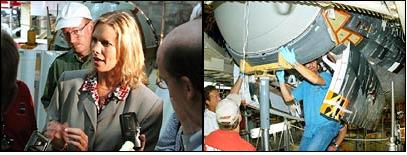Discovery will return to space
Avi Blizovsky

Right: Preparations for the Discovery flight begin. Left: Stilton is still working on the to-do list
Direct link to this page: https://www.hayadan.org.il/discovery030804.html
Almost 18 months after the Columbia disaster, the sister ship Discovery is undergoing a thorough overhaul in preparation for the relaunch of the space shuttle fleet. The project is overseen by a soft-spoken but ambitious woman, 34 years old. The space shuttle Discovery currently stands in a huge hangar, surrounded by scaffolding - as if she were the queen bee in the heart of the hive. Groups of three-four technicians and engineers hover around and inside the shuttle, attaching cladding, checking test equipment and checking last details on data sheets. The progress is slow but reliable, one shift of workers transfers a role to the next shift, and sometimes a night shift is also called in to complete urgent tasks.
According to the current schedule, Discovery will leave the hangar shortly after the beginning of the year, so that a leak-proof external fuel tank and two powerful rocket engines can be attached to it. After that, the spacecraft will be transferred to the launch pad and enter the orbit leading to the space station in March or April. This will be the first launch of a space vehicle developed by NASA, after the Columbia disaster that occurred on February 1, 2003.
Discovery performed a similar role in 1988, 30 months after the first space shuttle disaster. Seven astronauts were also killed in the Challenger disaster, and although the technical circumstances are different - the Challenger accident was caused by a faulty amplifier, while in the Columbia case parts of the fuel tank were splashed and damaged the heat shield - in both cases the investigation pointed to management failures. NASA is still in the midst of a process for renewed self-determination, but at the same time repairs are being made to the equipment.
In addition to the improvements introduced in the design of the fuel tank in order to prevent the flying of insulation foam during takeoff (among other things by giving up the insulation layer in the connection area between the shuttle and the external fuel tank), 88 new heat and acceleration sensors were also installed around the wings and inside. The data will be sent to engineers after launch so they can assess potential hazards to the sensitive heat shields. Additional cameras will monitor the launch of the shuttle and new tests will be performed before each takeoff.
The committee overseeing the implementation of the recommendations of the team that investigated the accident announced last week that the implementation of five of the 15 requirements has already been completed. However, to carry out the other requirements, NASA may need additional time. For example, it is possible that NASA will not have enough time until March to offer the possibility of repairing a tear of similar dimensions to the tear that opened in Columbia's wing.
Soon Idan new: back to flying
They knew the Columbia disaster
For news at the BBC
https://www.hayadan.org.il/BuildaGate4/general2/data_card.php?Cat=~~~914702299~~~188&SiteName=hayadan
